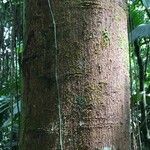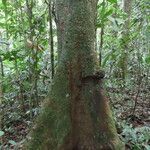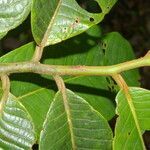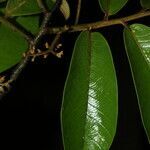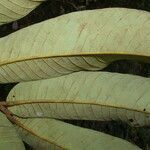Dioecious trees to 40 m., the younger branchlets densely tomentose to hirsute with ochraceous, usually evanescent hairs. Leaves glabrescent above except for the midrib, with persistent, ochraceous, stalked-stellate hairs below, coriaceous, oblong to narrowly ovate or obovate, apically acuminate or attenuate, basally cordate to acute, 13-38 cm. long, 4-13 cm. broad; secondary veins 18-35 on either side, averag-ing more than 1 per cm. along the midrib, the tertiary veins rather prominent below; petioles canaliculate, 7-16 mm. long, 1.5-4.0 mm. broad. Staminate flowers in few-branched panicles, the pedicels 1-5 mm. long; bracts ca. 5 mm. long, deciduous; perianth tardily 3-parted, 1.5-3.0 mm. long; anthers 3, 0.6-0.9 mm. long, usually connate to the apex, the infra-antheral portion of the androecium 0.5-1.2 mm. long. Pistillate flowers in clusters of 3-7 in racemes to 5 cm. long; pedicels 0.5-3 mm. long; tepals connate, with simple or few-branched hairs, the 1-carpellate ovary with a subsessile obscurely 2-cleft stigma. Fruits 1-5 per inflorescence, on pedicels 5-8 mm. long, the glabrescent ligneous pericarp ultimately dehiscing longitudinally into 2 valves, subglobose to ellipsoid, 18-30 mm. long, 16-21 mm. broad; seed ellipsoid to subglobose, the aril laciniate.
More
A tall tree. It can have large buttresses. The branches are high up and in groups of four held out from the trunk. The twigs have red hairs. The leaves are large and alternate. They are lighter green underneath with red hairs on the veins underneath.
